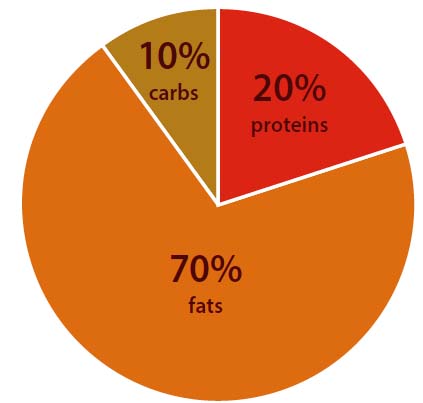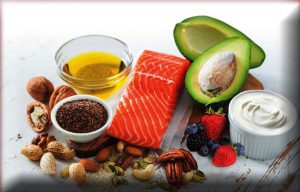
Ketogenic Diet – Introduction
Ketogenic is a very low carbohydrate method of weight loss that provides moderate amounts of excellent nutritional protein and excessive amounts of healthy nutritional fats. This reduction in the amount of carbohydrates enables the body to move towards a state that promotes the elimination of fats (meal plan and from your body) produces ketone bodies and enters a state that Is called “ketosis”.
When following a ketogenic food diet, your brain relies on ketones as a powerful source, in addition to the various organs. Ketones are produced inside the body once you reach the state of ketosis and inside the blood and urine it can be estimated that you will be in ketosis during this ketosis plan.
Healthy Ketogenic Diet
A cationic diet contains about 10% of the calories from healthy carbohydrates such as leafy greens, non-starchy vegetables, and a limited amount of liver and berry. 20% calories from protein such as omega 3 rich fish and Grass-fed animal protein; And cal 70 calories comes from high-quality fats such as avocado, unsaturated and medium chain triglyceride oil, nuts and seeds, and coconut.
This 10/20/70 ratio is a guideline for the distribution of micronutrients for a given day, which includes food, snacks, and beverages. Your doctor may recommend a slightly modified ratio based on your physical activity and health goals. The following comments highlight how calories from carbohydrates, proteins, and fats differ from the standard American diet and the normal ketogenic diet.

Benefits of a Ketogenic Diet
Benefits of following a ketogenic diet may include weight loss, increased cognitive performance, blood sugar balance and improved heart health.
- Mental focus – With ketogenic diet, the brain use ketone bodies in place of glucose as its primary fuel source. This switch can invigorate more nerve growth factors and synaptic connections between brain cells3 and bring about accelerated intellectual alertness, sharper focus, and improved cognitive capabilities.
- Blood sugar management – Research have proven that low-carbohydrate diets help to assist insulin metabolism inside the body. The deficiency of carbohydrates from the diet permit your body to maintain blood glucose levels by using breaking down fat and proteins.

- Weight loss – The low-calorie ketogenic diet encourages the use of body fat as a fuel, and clinical studies support its use in weight management. Additionally, a catechin diet may help suppress appetite and reduce cravings
- Increased energy – Carbohydrates only go to this place during the day and especially during exercise to maintain strength. In ketosis, fat is used as a gas instead of glucose, to provide our body with a regular supply of ketones, essential for maintaining physical function in your body.
- Cardiovascular and metabolic health – When following a ketogenic diet, you may want to keep your total carbohydrate intake to less than 50g per day. This can vary considerably, depending on what type of food you are currently eating. The information in the following sections will help you plan your meals and snacks so that you keep carbohydrates low while eating plenty of protein and fat. Your practitioner can help you make recommendations for daily service in each of the following categories.
Foods to Enjoy
-
Nonstarchy Vegetables
Serving size:
_________Serving/Per day
Leafy greens: Approximately 2–3 cups, raw
All others: ½ cup cooked or 1 cup raw
1 serving = approx. 25 calories
C = 5 g, P = 1-2 g, F = 0 g
-
- Artichoke
- Asparagus
- Bamboo shoots
- Bean sprouts
- Bitter melon
- Bottle gourd
- Broccoli
- Brussels sprouts
- Cabbage (bok choy, green, nappa, red, savoy)
- Cactus (nopales)
- Cauliflower
- Celery
- Celery root
- Chayote
- Cucumber
- Eggplant
- Green or string beans
- Hearts of palm
- Jerusalem artichoke
- Jicama
- Kimchi
- Kohlrabi
- Leeks
- Leafy greens (arugula, beet, collard, dandelion, endive, escarole, kale, spinach, Swiss chard, radicchio, watercress)
- Lettuce (Boston bibb, butter, frisee, green leaf, red leaf, romaine)
- Mushrooms
- Okra
- Onions (green, brown, red, scallions, shallot, spring, white, yellow)
- Peppers (bell, jalapeño, poblano, sweet)
- Radishes (daikon, cherry belle, white icicle, watermelon)
- Rutabaga
- Sauerkraut
- Sea plants (arame, dulse, kombu, kelp, nori)
- Sprouts
- Sugar snap peas, snow peas
- Summer squash (crookneck, delicata, yellow, spaghetti, zucchini, patty pan)
- Tomatoes
- Turnips
- Water chestnuts
-
Dairy
Serving/Day
Serving size: As Indicate
1 serving = approx. 100-150 calories,
C = 12 g, P = 8 g, F = 5-8 g
-
- Kefir, plain: 1 cup
- Milk: 1 cup
- Yogurt, plain, full-fat/whole milk, Greek: ½ cup
Note: Full-fat dairy products recommended
-
Protein
/Serving/Day
Serving size: As Indicate
1 serving = approx. 150 calories,
C = 0 g, P = 14-28 g, F = 1-9 g
-
- Bacon: 2 slices
- Beef
- All cuts: 3 oz.
- Buffalo: 3 oz.
- Cheese
- Cottage: ¾ cup
- Feta: 2 oz.
- Goat: 2 oz.
- Mozzarella: 2 oz. or ½ cup shredded
- Ricotta: 1/3 cup
- Chicken, white or dark meat: 3 oz.
- Cornish hen: 4 oz.
- Eggs, whole: 2
- Egg whites: 1 cup
- Elk: 3 oz.
- Fish
- Salmon
- Canned: 3 oz.
- Fresh: 3 oz.
- Smoked: 3 oz.
- Herring: 3 oz.
- Mackerel: 2 oz.
- Sardines (in water or oil): 3 oz.
- Trout: 4 oz.
- Tuna
- Canned, chunk light or solid light
- (in water or oil): 4 oz.
- Skipjack: 4 oz.
- Yellowtail: 4 oz.
- Salmon
- Lamb, leg, chop, or lean roast: 3 oz.
- Liver: 3 oz.
- Pork, tenderloin: 3 oz.
- Sausage: varies
- Shellfish (shrimp, crab, lobster, clams, mussels, oysters, scallops): 4–5 oz.
- Turkey, white or dark meat: 3 oz.
- Venison: 3 oz.
-
Oils & Fats
Serving/Day
Serving size: As Indicate
1 serving = approx. 45 calories
C = 0 g, P = 0 g, F = 5 g
-
- Avocado: 2 Tbsp.
- Avocado oil: 1 tsp.
- Butter: 1 tsp.
- Canola: 1 tsp.
- Coconut milk
- Light, canned: 3 Tbsp.
- Regular, canned: 1.5 Tbsp.
- Coconut oil: 1 tsp.
- Coconut spread: 1.5 tsp.
- Cream: 1 tsp.
- Cream cheese: 1 Tbsp.
- Flaxseed oil: 1 tsp.
- Ghee/clarified butter: 1 tsp.
- Grapeseed oil: 1 tsp.
- High-oleic safflower oil: 1 tsp.
- High-oleic sunflower oil: 1 tsp.
- Mayonnaise, unsweetened (made with avocado, grapeseed, or olive oil): 1 Tbsp.
- Medium-chain triglyceride oil: 1 tsp.
- Medium-chain triglyceride powder: 1/2 Tbsp.
- Olive oil, extra virgin: 1 tsp.
- Olives: 8–10 medium
- Sesame oil: 1 tsp.
- Sour cream: 2 Tbsp.
-
Nuts & Seeds
Serving/Day
Serving size: As Indicated
1 serving = approx. 45 calories
C = 0 g, P = 1 g, F = 5 g
-
- Almonds: 6
- Almond butter: 11/2 tsp.
- Brazil: 2
- Cashews: 6
- Cashew butter: 11/2 tsp.
- Chia seeds: 1 Tbsp.
- Coconut, unsweetened, shredded: 11/2 Tbsp.
- Flaxseed, ground: 11/2 Tbsp.
- Hazelnuts: 5
- Hemp seeds: 2 tsp.
- Macadamia: 3
- Pecans: 4 halves
- Pine nuts: 1 Tbsp.
- Pistachios: 12
- Pumpkin seeds: 1 Tbsp.
- Sesame seeds: 1 Tbsp.
- Soy nuts, roasted: 2 Tbsp.
- Sunflower seeds: 1 Tbsp.
- Tahini: 11/2 tsp.
-
Beverages
Unlimited servings/day
-
- Coffee/espresso
- Green tea, rooibos tea (unsweetened)
- Noncaffeinated herbal teas (mint, chamomile, hibiscus, etc.)
- Mineral water (still or carbonated)
- Sparkling water (free from sodium and artificial flavors)
- Water (ideally filtered)
-
Condiments, Herbs,& Spices
Unlimited servings/day
-
- Cacao (powder/nibs)
- Carob
- Blackstrap molasses
- Bone broth
- Flavored extracts (ex. almond, vanilla)
- Garlic
- Ginger
- Herbs, all, fresh or dried (ex. dill, basil, chives, cilantro, mint, oregano, rosemary, sage, thyme, etc.)
- Horseradish
- Hot sauce
- Lemon
- Lime
- Liquid amino acid
- Miso
- Mustard
- Salsa, unsweetened
- Soy sauce/tamari
- Spices, all, fresh or dried (ex. chili powder, cardamom, cinnamon, cumin, curry, garlic powder, ginger powder, onion powder, paprika, pepper, turmeric, etc.)
- Tomato sauce, unsweetened
- Vinegars, unsweetened, organic apple cider, balsamic, red wine, white wine
-
Allowable Sweeteners
Recommend limiting to 1–2 servings per day
to reduce cravings for sweet-tasting food
-
- Luo han guo (monkfruit extract)
- Stevia
Foods to Enjoy Occasionally
-
Legumes
Serving/Day
Serving size: As Indicated
1 serving = approx. 100 calories
C = 15 g, P = 7 g, F = 0-3 g
-
- Beans (black-eyed, black, cannellini, edamame,
- garbanzo, kidney, lima, mung, navy, pinto, etc.):
- ½ cup cooked
- Beans, vegetarian refried: ½ cup
- Bean soups, homemade: ¾ cup
- Hummus: 4 Tbsp.
- Lentils (brown, green, red, yellow, French): ½ cup, cooked
- Peas (pigeon, split): ½ cup, cooked
-
Berries
Serving/Day
Serving size: As Indicated
1 serving = approx. 60 calories,
C = 15 g, P = 0 g, F = 0 g
-
- Blackberries: ¾ cup
- Blueberries: ¾ cup
- Boysenberries: ¾ cup
- Cranberries, unsweetened: ½ cup
- Loganberries: ¾ cup
- Raspberries: 1 cup
- Strawberries: 1¼ cup
Foods to Avoid
- Processed sugary foods and sauces like soda, fruit juice, smoothies, ice cream, candies, etc.
- Grains or starches and wheat-based products like rice, pasta, cereal, etc.
- Most fruits except for limited amounts of berries
- Root vegetables and tubers like potatoes, carrots, etc.
- Lowfat or diet products
- Unhealthy fats such as processed vegetable oils
- Sugary alcoholic drinks (sweet wines and cocktails); always check sugar content
- Sugar-free diet foods that are often high in sugar alcohol or artificial sweeteners like aspartame, acesulfame K, and sucralose (such as Diet Coke, Splenda, Sweet ‘n Low)
- Fast food (pizza, burgers, pasta, etc.)
Mito Diet

Do you need to lose weight, increase energy, improve focus, and reduce body pain? Then you should know about the Mito Diet.
The term mito is an abbreviation for mitochondria. Mitochondria are structures in each cell that make energy by way of using oxygen and vitamins from meals.
Studies show that our mitochondria perform more efficiently with fats for a primary supply of gas as opposed to sugar or carbohydrates. Our cells in our heart, brain, muscle tissue and nerves have high concentrations of mitochondria, therefore are especially susceptible to sickness when our mitochondria do not get their right nutrition. With ultimate mitochondrial feature my patients have reduced fatigue, advanced energy, elevated muscle tissues and reduced excess fat.
The Mito Food Plan is high in high-quality fats, mild in great protein, low carbohydrate and gluten-free. The recognition of the food plan is to support wholesome mitochondria by ingesting therapeutic meals that improve strength production.
There are similarities with the Mito Food Plan and the Ketogenic Diet. The benefit of the Mito Food Plan is that it’s far designed for long term use. Many humans have hassle following the Ketogenic Diet long term.
Vegetarian Diet
A vegetarian diet consists of plant foods, including vegetables, fruits, grains, legumes (beans, peas, lentils, etc.), as well as dairy products, such as milk, cheese, butter, yogurt, and ice cream.
In other words, a vegetarian diet means a vegan diet plus dairy.

Benefits of Vegetarian Diet
- Vegetarian cuisine is naturally low in saturated fats. Foods of plant origin contain no cholesterol.
- Plant foods are high in fiber, while animal foods contain no fiber.
- Many plant foods contain significant amounts of B vitamins, including folic acid. Fruit and vegetables are powerful sources of phytochemicals: nutrients that help every organ of the body work better and help prevent cancer and infections.
-
Vegetarians have a tendency to eat fewer calories, on account that grains, legumes, fruits, and vegetables, volume-for-volume, have a tendency to be decrease in calories than meat and poultry. Studies have proven that so long as a weight loss plan is balanced and nutritious, people who eat fewer total daily energy stay longer and more healthy lives.
Health Benefits
- Weight loss – Who use a vegetarian diet to lose weight are not only more successful at losing weight, but they also have better luck keeping that lost weight off. A handful of well-respected studies have found that vegetarians are less likely to be overweight or obese, and tend to have lower BMIs, compared to omnivores.
- Healthier Heart – Vegetarian diets are associated with a lower chance of cardiovascular disease. Eating a vegetarian diet also can improve other danger elements for heart disease, like decreasing your blood stress and cholesterol and decreasing inflammation, which encourages plaque buildup to your arteries.
- Lower Diabetes Risk – Eating a vegetarian diet lowers your chance of diabetes – irrespective of what your BMI is. Plus, people who devour a plant-based food plan are more insulin-sensitive, says more recent research.
- Better nutrition – Research shows that people’s overall nutrition is usually better when they follow a vegetarian or vegan diet versus when they eat an omnivorous diet. Plus, most of us don’t eat the daily recommended produce amounts, so making your diet mostly, or exclusively, plant-based will help you reach those targets.



